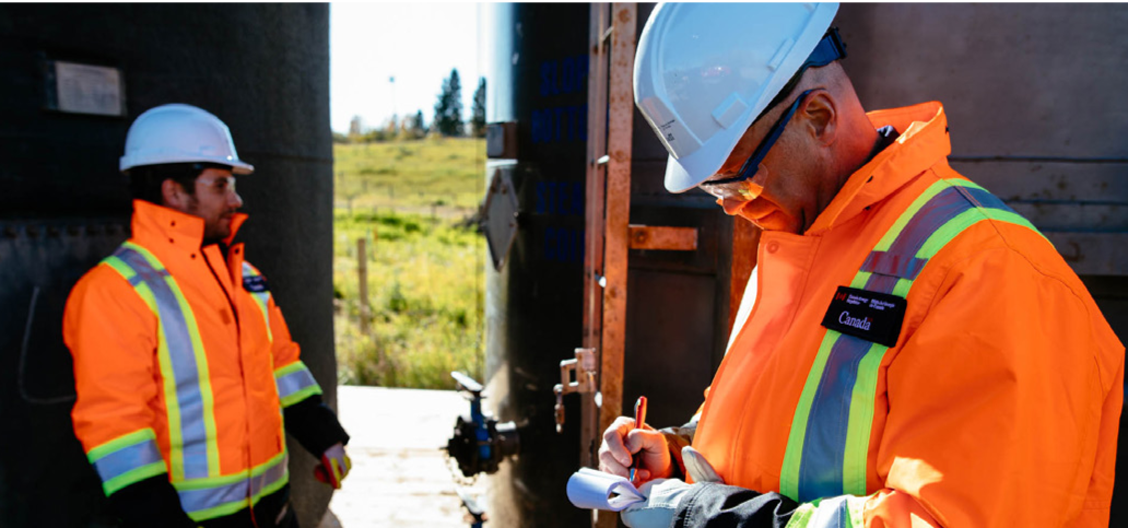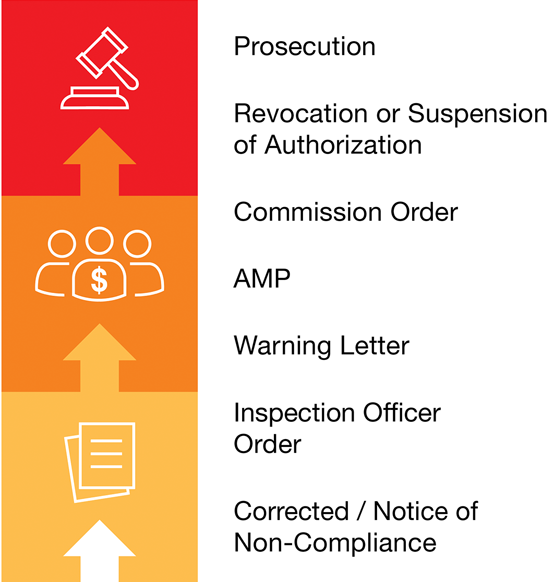The Canada Energy Regulator’s Enforcement Policy
The Canada Energy Regulator’s Enforcement Policy [PDF 232 KB]
Copyright/Permission to Reproduce
Table of contents


Introduction
The Canada Energy Regulator (CER or Regulator or Commission) is an independent federal regulator of several parts of Canada’s energy industry. The CER reports to Parliament through the Minister of Natural Resources.
Through its safety and environmental oversight mandate, the CER regulates:
- the construction, operation, and abandonment of pipelines that cross international borders or provincial boundaries, as well as the related pipeline tolls and tariffs
- the construction and operation of international power lines and designated inter-provincial power lines
- the construction and operation of offshore renewable energy project and offshore power lines
- exports of crude oil, natural gas liquids, natural gas, refined petroleum products, and electricity
- oil and gas exploration and production activities in specified areas that are not regulated under joint federal/provincial accords
CER inspection officers will verify and enforce compliance with regulatory requirements during all phases of a project, from application to construction, operation and maintenance, as well during temporary or permanent suspensions of a pipeline such as deactivation, decommissioning and abandonment. The CER also investigates matters of alleged non-compliance as a result of complaints, reports of high-risk activity or incidents.

Purpose
This policy document describes the CER’s approach to enforcing regulatory requirements under its mandate. This approach is based on the principle of a compliance and enforcement continuum, which includes ensuring compliance with regulatory requirements, and escalating matters of non-compliance for appropriate action when required.
Where non-compliance occurs, the CER will take necessary compliance and enforcement action to bring companies back into compliance, and/or deter future non-compliance based on a graduated enforcement model. This document is also intended to provide guidance to CER staff, industry and the public on guiding principles, processes and tools supporting all CER enforcement actions.
- This document is a guidance tool and is not intended to provide legal advice. The Acts and regulations take precedence over any guidance provided in this document. Professional judgment and discretion exercised by decision-makers in carrying out their duties may also affect the implementation of this policy.
Scope
Most of the CER’s responsibilities are set out in the Canadian Energy Regulator Act, Canada Oil and Gas Operations Act (COGOA), and the Oil and Gas Operations Act (OGOA)Footnote 1, as well as their associated regulations (collectively, “the Acts”). The scope of this document applies to the administration and enforcement of these Acts and regulations.
The Chief Executive Officer (CEO) designates officers under the Acts to conduct compliance verification activities to ensure the safety of Canadians and protection of the environment, and in the case of the COGOA and the OGOA, on the conservation of resources. The CER primarily regulates pipeline companies that hold a regulatory authorizationFootnote 2 from the Commission.
Although some CER staff have delegated responsibilities under the Canada Labour Code (CLC), Part II, for the occupational health and safety of pipeline company field staff and contractors, this policy does not apply to enforcement taken under the CLCFootnote 3.
Guiding Principles
The CER applies the following guiding principles in implementing compliance and enforcement activities under its mandate:
- In order to prevent harm to people and the environment, the CER will use the most appropriate tool(s) available to obtain/promote compliance with regulatory requirements.
- The CER implements a compliance and enforcement continuum to address non-compliance(s), which includes escalating matters of non-compliance for appropriate action when required.
- Where non-compliance occurs, the necessary compliance and enforcement actions will be used to bring companies back into compliance, and/or deter future non-compliance.
- CER inspection officers will administer the Acts and regulations under its mandate in a manner that is fair, predictable and consistent.
- Meeting the federal government’s direction for transparency, the CER makes information on its compliance and enforcement activities available to the public.
Responsibilities
The CER Act, COGOA and the OGOA establish the following responsibilities for the CER’s compliance and enforcement activities:
Canada Energy Regulator
The CER includes an independent Commission whose members are appointed by the Governor in Council. The Commission is a court of record, with powers, rights and privileges of a superior court, and has full and exclusive jurisdiction under section 32 of the CER Act to inquire into, hear and determine any matter under its jurisdiction. The Commission may make orders or give direction for any person to take measures as required by the Act or regulations, or that the Commission considers necessary to ensure the safety and security of a pipeline.
Designated Officers under the CER Act
The CEO may designate employees of the CER as Designated Officers pursuant to section 24 of the CER Act to make certain decisions on administrative or technical matters.
Inspection Officers under the CER Act
Inspection officers are designated by the CEO under section 102 of the CER Act:
- to ensure the safety and security of persons;
- to ensure the safety and security of regulated facilities and abandoned facilities; and
- to ensure the protection of property and the environment.
In order to carry out their duties, inspection officers have powers under ss. 103(2) of the CER Act and undergo extensive training and certification processes. Enforcement specialists provide Inspection Officers enforcement support and advice on matters requiring enforcement follow up, and provide assistance to staff on taking appropriate enforcement action.
Safety and Conservation Officers under COGOA and OGOA
Safety and Conservation Officers are designated pursuant to section 3.1 or section 53 of COGOA and section 4 or section 105 of OGOA for the purposes of the administration and enforcement of the respective Acts and regulations.
In order to carry out their duties, officers have powers to:
- enter any place, including lands, buildings, installations, vessels, vehicles and aircraft, used for any work or activity in respect of which the Acts apply;
- take photographs, make drawings, take samples or have carried out any reasonable tests or examinations;
- order that any place or thing referred to in this section not be interfered with for a specified period;
- require the production, for inspection or copying, of any books, records, documents, licences or permits required by these Acts or the regulations; and
- take samples or particulars and carry out, or have carried out, any reasonable tests or examinations.
Administrative Monetary Penalty (AMP) Officer under the CER Act and COGOA
This is a designated person authorized to review and issue the Notice of Violations, and is involved in the review process and providing direction on external publication and communications with regard to AMPs.
Public Prosecution Service of Canada
Federal public prosecutors are responsible for all prosecution matters under the Acts, and ultimately make decisions on whether to proceed with charges against a company or individual.
Public Duties
Under subsection 103(4) of the CER Act, section 56 of COGOA and section 108 of OGOA, company officials, agents and persons are required to provide all reasonable assistance to officers while carrying out their duties. Under sections 106 and 107 of the CER Act, section 57 of COGOA and section 109 of OGOA, no person shall obstruct or hinder or make a false or misleading statement, either orally or in writing, to an inspection officer, a safety officer, the Chief Safety Officer, a conservation officer or the Chief Conservation Officer who is engaged in carrying out duties and functions under the Acts or the regulations.
The Enforcement Framework
CER inspection officers verify compliance with legislation, regulations, and a variety of regulatory instruments throughout the lifecycle of a pipeline and/or project. This section provides an overview of how they implement various levels of regulatory action to correct non-compliances based on a continuum of compliance and enforcement activities.
Compliance verification
The Regulator conducts compliance activities to verify that regulated companies and third parties are complying with the Acts and regulations under its mandate, as well as the conditions of their certificate, order or permit (authorizations issued by the CER to construct and operate), and commitments.
In doing so, the Regulator will undertake compliance verification through on-site inspections, audits, compliance meetings with regulated companies, and review of relevant documentation. Compliance is achieved when legal requirements are met and companies fulfill the expectations set by the Regulator.
Enforcement
When non-compliances are observed, the CER will follow up to ensure the situation is corrected and ensure compliance is achieved. Enforcement is used in response to non-compliances to deter future non-compliance and to prevent harm. It is one of the means the CER uses to promote compliance with the various acts and regulations under its mandate.
The Enforcement Toolkit
Should a person or company not comply with regulatory requirements, the Regulator may take compliance and enforcement actions. The CER has a variety of tools available to ensure compliance and avoid repeated occurrences of non-compliances. CER’s compliance and enforcement tools are not mutually exclusive (except for AMPs and prosecution),Footnote 4 and more than a single tool may be employed to obtain or promote compliance, deter future non-compliance or to prevent harm.
The following compliance and enforcement tools are available in the CER’s toolkit:
a) Corrected Non-Compliance (CNC) and Notice of Non-Compliance (NNC)
A CNC and NNC are tools issued by an inspection officer to an CER-regulated company, individual, or third party when a non-compliance is observed during a compliance verification activity.
These tools are meant to resolve compliance issues. If issues of non-compliance are corrected during the course of the inspection activity, and addressed to the officer’s satisfaction at the time of the inspection close out meeting, this will be documented in the inspection report as a CNC. If more time is required to address non-compliance(s), an inspection officer determines an effective corrective action and due date with an NNC pursuant to s. 108 of the CER Act.b) Inspection Officer Order
A CER or COGOA/OGOA Officer, on reasonable grounds, may issue an order under certain conditions specified in the Acts. An order is a statutory enforcement tool issued pursuant to section 109 of the CER Act, subsection 58(1) of COGOA or subsection 110(1) of OGOA.
The officer order will be used to ensure that necessary action is taken to rectify the situation within a timeframe specified by the officer. The order may require immediate suspension of work or cessation of the operation/activity, and/or require special measures or terms to be undertaken to address the non-compliance or hazard. An order will always be given in writing, but if circumstances warrant, an order may first be issued verbally. If an officer issues an order under the CER Act, s/he must report it back to the Commission.
Once the officer is satisfied that the terms and conditions of the order have been met, or that the situation has been remedied, he/she will inform the company, either verbally or in writing, that any suspended work or ceased operation/activity may resume.
Orders issued by officers under COGOA and OGOA expire 72 hours after they have been issued, unless they are confirmed by order of the Chief Safety Officer or Chief Conservation Officer, as the case may be.
A recipient of an officer order may request a reviewFootnote 5 by the Commission, pursuant to section 71 of the CER Act, subsection 58(5) of COGOA or subsection 110(5) of OGOA. The request for review does not stay the order, and that means that the suspension of work or conditions of the order must be met until the Commission decides otherwise.
In some circumstances, additional enforcement measures may also be used subsequent to the order being issued to deter future non-compliance. Failure to comply with an officer order is a punishable offence and can lead to an escalation of enforcement responses.
c) Warning Letter (WL)
A Warning Letter (WL) is a non-statutory administrative enforcement tool intended to elevate compliance matters to the attention of senior company officials (typically, the designated Accountable Officer) or third parties in order to generate the necessary action to return to compliance if the non-compliance has not been addressed. If the matter has already been addressed, a WL will be used to inform recipients of the seriousness of the issue, and of possible escalation of further action should the non-compliance re-occur.
d) Administrative Monetary Penalty (AMP)
An Administrative Monetary Penalty (AMP) is a statutory financial penalty imposed on individuals or persons other than an individual (e.g. companies) in response to a contravention of, or failure to comply with, specified provisions in the CER Act and COGOA, and their associated regulations. All potential violations are listed in the Administrative Monetary Penalties Regulations under the CER Act and COGOA. An AMP can be used instead of, or in conjunction with, other enforcement tools depending on the circumstances that lead to the non-compliance and the nature/severity of the violation.
AMPs will be used when compliance has not been obtained using other compliance and/or enforcement tools, harm is caused or is likely to be caused by the non-compliance, or in any other situation where it is deemed the best way to promote compliance by deterring future non-compliance.
Under the Acts, the CEO or Commission has designated an AMP Officer to issue notices of violation, which is the form used to issue the AMP.
The recipient of a Notice of Violation has the right to have either the facts of the violation, or the amount of the penalty, or both, reviewed under section 125 of the CER Act or section 71.2 of COGOA. If a review is requested within the specified timeframe, a Panel is appointed to conduct the review.
e) Commission Order or Direction
If other enforcement tools are not achieving the desired result of obtaining compliance, and/or there are specific safety and environmental concerns to address, then the matter may be referred to the Commission for consideration of an order or a letter of direction.
Commission orders are binding on parties and may be issued at any time and may contain direction for the company to take any measure(s) the Commission feels is necessary to address any safety and/or environmental issues or non-compliances. Letters of direction may be used when the Commission requires companies to take specific action, or stop activity, with respect to a non-compliance, without needing to impose any terms or conditions.
f) Revocation or Suspension of Authorization
If the Commission has lost confidence in a company’s ability to operate safely and in a manner that protects people and the environment, or if any term or condition of a certificate, permit, order or operating license is not complied with or has been contravened, the Commission may vary, revoke or suspend the company’s authorization to operate, in whole or in part.
Through a “Show Cause” hearing process, the company will be given the opportunity, according to the principles of natural justice, to present evidence, either orally or in writing, regarding why such measures are not necessary. Should the company wish to restore operation of its pipeline or related facilities following a revocation or suspension, it can make an application to the Commission and will be required to demonstrate its capability to operate the facility in a manner that is safe, secure and protects the environment.
g) Prosecution and Court Options
It is an offence to contravene certain provisions of the CER Act, COGOA, OGOAFootnote 6 and the regulations under these Acts. Any person found guilty of such contraventions could be subject to fines and/or imprisonment. The prosecution of offences under the Acts or its associated regulations is carried out by the Public Prosecution Service of Canada.
Commission orders or decisions may be made a rule, order or decree of the Federal Court or of a superior court of a province, per section 64 of the CER Act, for the purposes of enforcement. This introduces a wider range of enforcement options, including the possibility of a criminal proceeding for contempt of court punishable by fines or imprisonment or both.
These options may be considered if the investigation uncovers evidence of negligence, intent, or repeated violations that have caused, or could lead to serious harm or hazards.
Considerations in the Application of Enforcement Tools
When selecting the most appropriate action to take, the CER’s responses to non-compliances will be fair, predictable, consistent, timely and transparent based on the following considerations:
- Nature of the non-compliance: enforcement responses will depend on the seriousness and severity of the harm, or potential harm, to the public and the environment; the intent and negligence on the part of the company or individual; the level of cooperation received to achieve compliance or mitigate the situation; and the history of past violations.
- Achieving the desired outcome: the most appropriate tool(s) will be used to meet the desired result of compliance with regulatory requirements within the shortest timeframe, and may result in an escalation of enforcement responses if necessary.
- Applying consistent enforcement: when deciding what enforcement action to take, the CER will consider previous compliance history, due diligence on the part of the violator, and consider how similar situations were resolved in the past.
The CER’s tools will form part of the CER’s records when planning future CVAs and in determining what enforcement action should be taken in the future should there be re-occurring non-compliances by the company.

Graduated Enforcement Response Model
Compliance and enforcement actions are implemented on a continuum, and may escalate depending on the nature and severity of the non-compliance, the exercise of due diligence in preventing the non-compliance and level of cooperation to achieve compliance based on the following graduated enforcement response model:
When non-compliances are identified, CER staff will apply the enforcement considerations when assessing the non-compliance, and determine the best course of action. Although the usual process that is followed for routine non-compliances is a step-by-step approach that begins with CNCs/NNCs, matters will be escalated for consideration of more aggressive enforcement action based on the nature and severity of the non-compliance. Files that are referred to the Enforcement team will be investigated to determine whether further action is warranted, and the most appropriate tool to use depending on the circumstances of the non-compliance or violation. Each case file is individually assessed and if there is a situation with egregious circumstances, the CER will escalate its response accordingly.

Graduated enforcement response model
- Corrected / Notice of Non-Compliance
- Inspection Officer Order
- Warning Letter
- AMP
- Commission Order
- Revocation or Suspension Authorization
- Prosecution

Transparency
The CER is committed to providing information to the public on the safety of the pipelines and facilities it regulates, including information on its companies and enforcement actions. These actions will be posted to the CER’s external website.
Find out more
Find out more about the Canada Energy Regulator
by visiting us online.
Be sure to follow us on social media for the latest updates.
For copies of any CER publication or for more information, contact us:
ONLINE: www.cer-rec.gc.ca
EMAIL: info@cer-rec.gc.ca
TOLL FREE: 1-800-899-1265
Write us or visit our library at:
Canada Energy Regulator
210-517 10 Ave SW
Calgary AB T2R 0A8
- Date modified:
